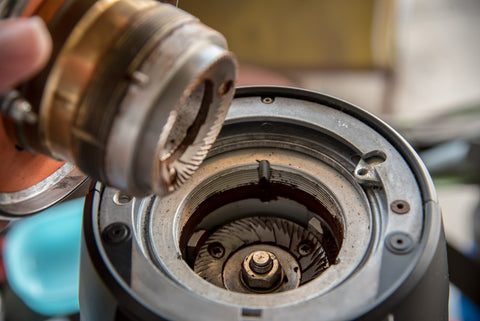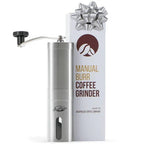Your coffee grinder is the most important part of your coffee setup. It’s what preserves the fresh flavors of whole beans. It’s what enables you to brew using a variety of coffee devices. But if you want it to keep serving you so well, you’re going to have to maintain it.
Caring for your electric coffee grinder doesn’t just make it last longer, but it also keeps old grounds and rancid oils from tainting the flavor of your later brews.
And here’s the good part: caring for your grinder just takes a few minutes every month or so. It’s quick, easy, and goes a long way towards making amazing specialty coffee.
Whether you have a smaller electric grinder or a big-time espresso grinder, here’s how it works.
Read: How To Pair Your Coffee Brewer With Its Perfect Grind Size
Tools You (May) Need To Clean Your Grinder
Here’s the goal: clean off as many stubborn grounds and soak up as many oils as possible. When these things build up and get knocked off by grounds days or weeks down the road, they tend to mess with your coffee’s flavor and balance.
Here’s what you need to keep your grinder in top condition:
- A grinder brush
- A dedicated grinder cleaner
- A microfiber cloth
- A vacuum (optional)
- Pressurized air (optional)
The first three tools shouldn’t run you more than fifteen dollars or so and they’ll last you for months or years. Don’t pull the plug yet on the last two though—you may not need them.
Can’t I Just Use Rice?
Grinding uncooked rice to soak up oils is a popular way of cleaning grinders, but we highly suggest you don’t do this. Not all cooked rice is the same, and sometimes the rice is so hard it breaks burrs or strains motors.
In fact, Baratza, one of the most popular home grinder makers, won’t fix your grinder on warranty if you have an issue after grinding rice.
Nope, we suggest using a dedicated grinder cleaner. These tablets are not expensive but are much more effective.
The Monthly Cleaning Routine
Cafes go through this process once or twice per week, but they’re going through lots of coffee. You just need to do this about once per month. I suggest you set a repeating reminder on your phone every four weeks or so—easy!
Read: What To Look For In A Travel Coffee Grinder
Here’s how it works…
- Clean out all the grounds from your hopper. If you store beans in the hopper, remove them all. Grind any beans you can’t get to. Make sure the grinder is turned off before you dig your fingers near the burrs!
- Grind dedicated cleaning tabs. These tabs are specifically designed to soak up the most stubborn coffee oils, which keeps them from congealing and going rancid inside your grinder (talk about gross). Now run a handful of old beans through to knock out any remaining cleaner residue.
- Turn the grinder off. Remove the hopper and start disassembling the burr construction. Use a white towel to keep all the pieces where you can see them. For most grinders, this is pretty simple. Use the manual to make sure you’re doing it right for your model.
- Time to use that brush. Using your grinder brush, scrub the sides of the burrs to knock off any remaining fine grounds. Now scrub around the inside of the grinder around where the burrs are located to get any final stuck grounds down the chute.
- Optional: vacuum or shoot with air. You can use a vacuum to suck up these newly dislodged grounds. You can also use pressurized air to make sure they get shot down into the chute and out of the grinder. Not essential, but for the extra-thorough folks.
- Reassemble the grinder. Put the pieces back together in the order you took them out.
You now have a totally clean grinder that’s ready to produce uniform, consistent grounds for you. Oh, and those leftover grounds and oils won’t hurt your coffee flavor—so that’s good.
Read: Should You Store Your Coffee Beans In The Freezer?
Burrs: When Do They Need To Be Replaced?
No two grinders are the same, so it’s important to check with your manufacturer to see about how long your grinder can last per set of burrs.
- For filter brewing grinders, this can be 2-3 years
- For espresso grinders, it’s often 1-2 years
If, when you’re cleaning the burrs, the edges just don’t feel sharp anymore, it’s probably time. You can read all about how to tell when your burrs need to be replaced in this blog post.
---
Cleaning your grinder isn’t just about a clean device—it has lasting effects on the burr sharpness, grinder efficiency, and your coffee flavor. If you want to truly experience the best flavors your coffee has to offer, don’t get lazy with the cleaning side of things.
But the obvious way to brew the best coffee you can is to, of course, start with amazing coffee.



